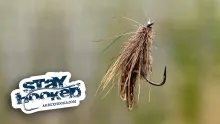CDC wings are good looking and makes a dry fly a great floater. Here's a few tips on getting them perfect.
Tying wings with CDC is simple but, depending on the fishing situation, it is very important how the fly looks on the water.
If the fly has an imprint in the water surface close to the natural, the fish will usually take it in the spring and the summer. Trout are not so picky, but more sensitive to the presentation of the fly and at the presence of the fisherman. Grayling are more careful when they take flies: shape, size and color together with presentation - how the fly is floating - is important. The presence of the fisherman is not quite as important.
At the end of autumn and in the first part of the winter the footprint of the fly is critical. All fish will be more careful with what they eat.
In this period, in Central Europe, there are a lot of hatches of small olives and other small insects. The fish will eat in frenzy because the winter is close. The waters are low and gin clear, and fishing with dry flies is absolutely spectacular if you use the right flies.
Based on my own and my friends' experiences from Slovakia, Poland and the Czech Republic, I noticed that it is very important how the CDC wings are mounted on the flies, especially when we tie dun and spinner flies.
The first and most popular way of tying wings with CDC is the simplest one: fix two or three CDC feathers on the body and the fly is ready (Marjan Fratnic style). Of course the fly looks nice, the footprint in the surface in is clear and clean, but after a few casts and a few fish caught, the CDC wing will lay over the body of the fly and will look more like a sedge and not like a dun fly.
|
|
|
|
|
|
|
|
The number of fish will decrease right away because the fly will not look like those that are hatching. If you are looking on the water you will notice that the wings of the insects are upright.
It's very simple to correct this: just add a few turns of dubbing to make a thorax big enough to keep the wings upright. The thorax area will look nice and will keep the CDC in the best position and the spiky dubbing will also imitate the legs of the insect.
The only problem is when you want to tie small flies, on size #18-22 hooks. The stem of the CDC feathers is a little bit thick, and it is difficult to make a nice and small head. A good solution is to tie the wing of CDC using the barbs only without any stem. For big flies it's OK to use the entire feather but on small flies it's difficult and a lot of waste if you use only the feathers tips. So you can use the barbs from surplus CDC feathers and utilize what remains when you tie medium size flies.
You can see bellow how the used feathers look. It's a pity to throw away these feathers just because they have the tips clipped. Just use a bulldog clip, a PetitJean clip or a Vosseler clip to take the beautiful barbs from the base of the feathers and make a wing with them.
Another great solution to have erect wings that will not lay over the body is to tie the CDC barbs pointing towards the eye of the hook and not the bend of the hook.
When the body is ready, just add a few turns with spiky dubbing to help the CDC barbs to stay upright. Two turns behind the wing and three in the front, make the head and the fly is ready!
- Log in to post comments



























